A programmer and a lumberjack walk into a bar… And walk out with a hipster, wooden robot.
It is not a joke. You and your kids can build and program a robot made out of wooden parts and bare electronic modules. Aren't you curious how it will turn out?
Codebox by LOFI is a bare and straightforward tool for teaching robotics and programming. Made out of raw wooden elements connected with bolts, basic electronic modules and an Arduino controller, this educational tool is an interesting and price-competitive product. Especially when compared to other robotics kits designed for the same market segment.
We decided to check this unusual educational tool and test LOFI Codebox ourselves.
Let’s start by putting this kit in the most recent historical context. You see, Codebox is the result of lessons learned from the previous generation of LOFI robotics kit, Edubox.
Weaknesses of the previous kit, like the long time needed to assemble robots (that made it impossible to use Edubox during regular school classes), were taken into account already at the design stage. The new kit and new materials resolve this problem and actually make it feasible to use Codebox in class.
Now, you can purchase Codebox Starter, the base kit with electronics and construction elements. There are also two expansions available: Codebox Drive for building vehicles and Codebox TV – a simple, programmable LED screen. Producer also offers some additional elements, such as a voltmeter, or modules enabling Bluetooth communication.
Our team was able to test out the basic kit and the expansions for several weeks.
So what are the main pros and cons of Codebox by LOFI? How to use this robot in school education? Or does it work better in homeschooling?
To answer these questions, we have taken a good look at the new robotics kit by LOFI.
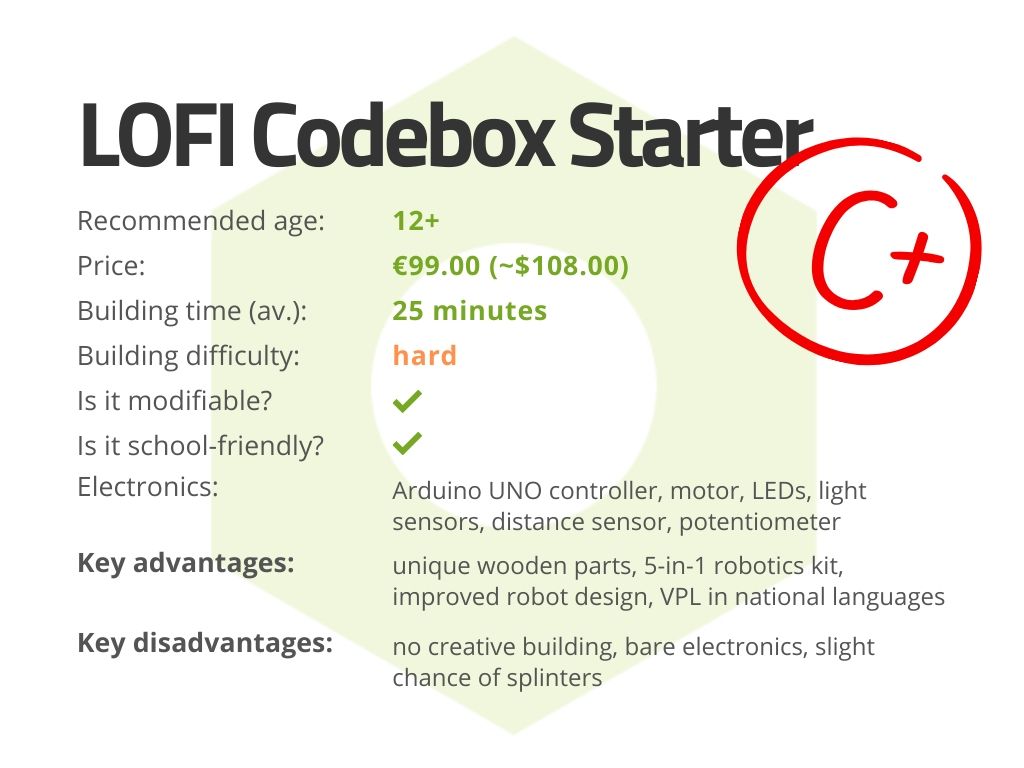
Construction¶
All LOFI products are made from Arduino-based electronic elements and laser-cut wooden parts. To join these wooden parts together, you use tiny nuts and bolts. Fortunately, the kit contains a screwdriver.
Building LOFI robots is quite demanding manually. You need nuts and bolts to create two types of connectors: parallel and perpendicular ones.
Out of the two, perpendicular connections are more difficult to make. You use square-shaped nuts and cleverly designed incisions in wooden parts to make bolts pull elements together. Thanks to this solution, you get durable and inflexible joints. But creating them presents some manual challenges. Expect to be juggling wooden parts, tiny bolts, nuts and the screwdriver at the same time.
Despite difficulties inherent to the assembling process, building LOFI robots is really rewarding. You will enjoy it all the more, if you have a knack for DIY and working with wood. The bareness of parts gives children the impression of creating something from scratch, which produces tons of joy and has a positive effect on their self-esteem and determination. Needless to say, kids develop motor skills and work on their patience.
Due to the specific character of robot assembly, we recommend LOFI sets for kids above 12 years old (official producer recommendation: 10-14 YOA).
Tips for joining perpendicular elements:
Place your finger below the space for a nut. It will help you hold the nut in place and tighten the screw. If the connection is difficult to reach, shift your robot to a position that allows you to turn the bolt downwards. Carefully place the nut and start screwing it in.
Unfortunately, wooden construction parts are not versatile. As things stand right now, Codebox cannot be used to expand creativity in terms of building. The contents are a collection of purposefully created elements, all designed to assemble several interesting robots. From this point of view, Codebox Starter is a 5-in-1 robots kit, not a creative building set. Consequently, creating your own robotic model from these parts is going to be a very challenging task.
On the other hand, if you are lucky enough to have access to a laser cutter, you can easily create construction parts of your own design out of cheap sheet wood!
Durability is another probable cause for concern. Wooden parts can be easily damaged, either due to wear and tear, or a careless separation from the sheet. What’s more, small nuts and bolts can be easily displaced, especially when working in a group.
The good news is that the electronics are aplenty. Codebox Starter provides you with many useful electronic modules - jump to the set contents for more details.
Rich collection of motors and sensors gives you a lot of possibilities, especially in terms of interacting with your robot’s surroundings. Electronics allow you to build and program engaging devices, despite the minimal number of construction parts.
However, LOFI electronics are not completely trouble-free. Since modules are practically bare, they are prone to damage. Connectors may also be problematic, since it’s easy to confuse ends or bend pins by accident. And pay attention to the wiring; insulation is quite delicate, so careless bending can lead to permanent malfunction.
Codebox Starter: What’s inside the box?¶
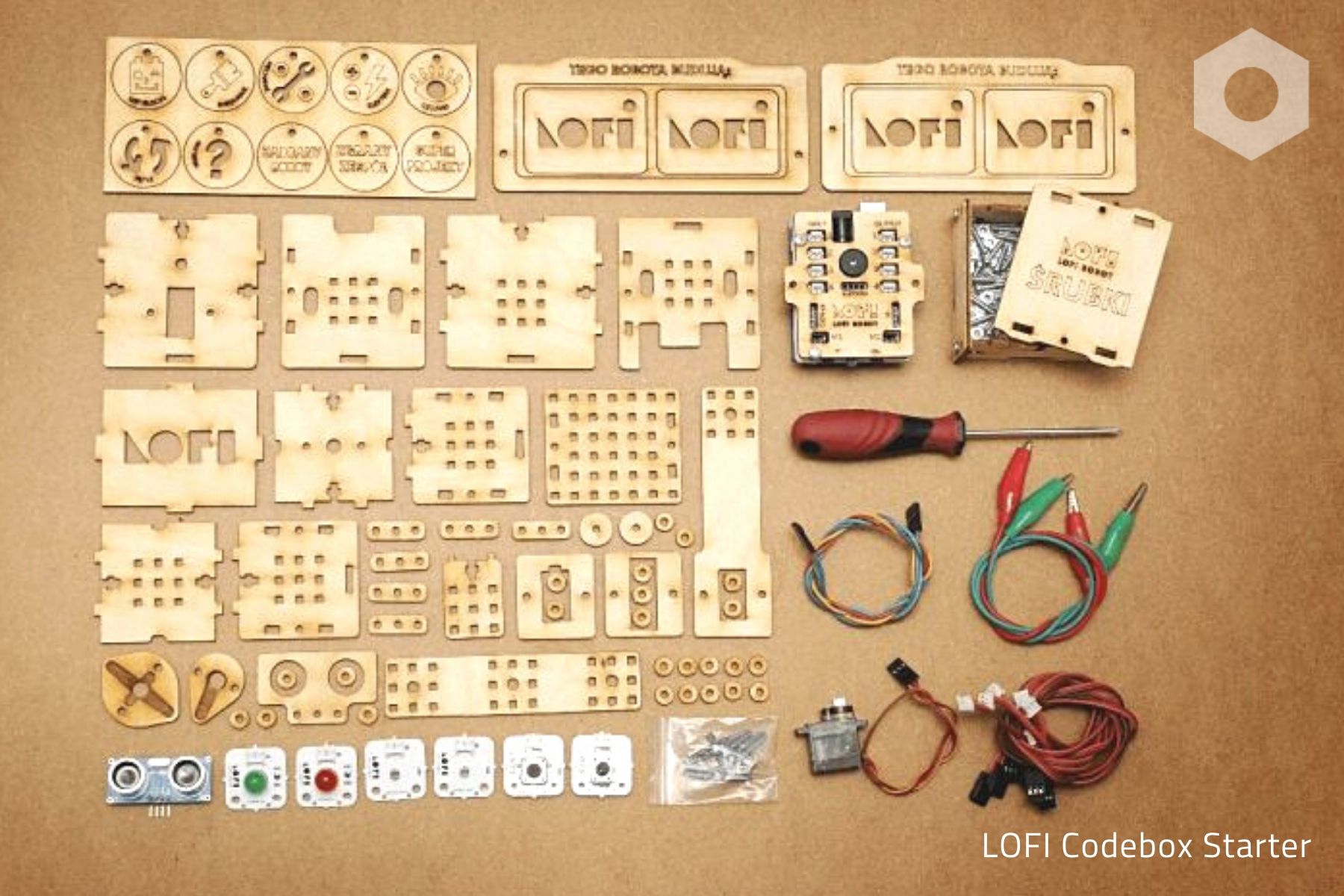
Everything you need: wood and electronics. Let’s begin with elements that are crucial for bringing robots to life.
Electronic modules are the most important part of the base kit. They include an Arduino UNO controller with LOFI Brain 2.0 adapter, 1 servo motor, 2 LEDs, 2 light sensors, 1 distance sensor, 1 button and 1 potentiometer module.
Worry not, the kit also includes less interesting, but equally essential elements, such as cables for connecting the modules with the controller, a USB cable for connecting the controller with a computer and cables with crocodile clips. When it comes to electronics, Codebox Starter has got you covered.
What is LOFI Brain?
Adapter that makes connecting other electronic elements easier by means of sockets and plugs. It is equipped with 4 input connectors (for light sensors, potentiometer and button), 4 output connectors (for LEDs and servomotors), distance sensor socket, DC motor sockets, Bluetooth port, micro USB to connect a powerbank and a built-in buzzer.
For building robots, Codebox Starter gives you 4 sheets of wooden construction parts, additional parts for assembling a wooden container box, plastic elements for connecting wooden elements with the servomotor and a set of nuts & bolts with a screwdriver. There’s a nice bonus inside: wooden badges and frames for kids.
Overall, construction elements in this set are few. Especially since one of four wooden sheets actually contains parts for assembling a wooden container for nuts and bolts.
In total, you get 22 wooden construction parts, not counting the wooden gaskets for bolts. They allow you to build the robot’s body (i.e. cubic boxes) in two sizes, cases for the distance sensor and servo motor, as well as a mobile arm.
Read on to discover what extensions are available, or jump forward to see what robots you can build with Codebox Starter alone.
Codebox Drive: Wooden robots on wheels¶
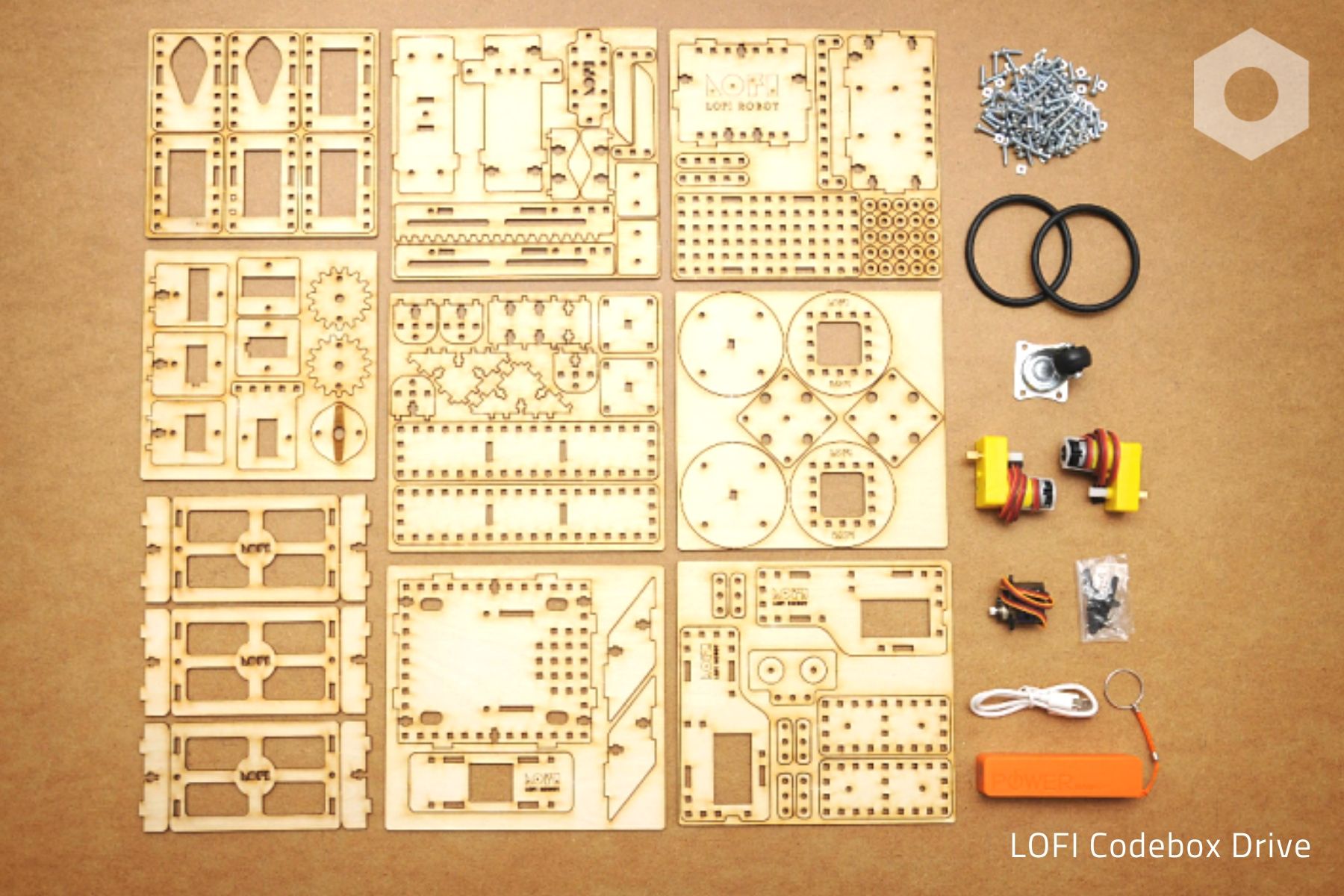
Sold separately, this expansion boosts construction possibilities of the base set. Equipped with Codebox, you can build 7 vehicles.
Note:
Remember that this product is not a standalone kit. In order to build and program robots, you will also need the Starter set, which contains the controller board.
Codebox Drive equals more construction parts. They hide under the guise of wooden sheets, out of which you can take 75 elements (not counting wooden gaskets) in total. Wooden parts are accompanied by nuts and bolts, a metal support wheel and tires - very helpful in creating mobile robots.
Although the sheer number of elements is impressive, they share the same problem - individual elements are not adaptable. They don’t encourage young constructors to experiment on their own. Nevertheless, with a larger number of parts, creating your own robot model is achievable. Not easier, but it can be done.
The expansion also comes with some fresh electronics. Inside the box, you will find 2 DC motors, another servo motor and a powerbank, which helps you make your robot independent from the computer’s power.
Note:
If you want to code your robots in one of VPLs available, not the advanced Arduino IDE, you won’t be able to use the powerbank without some separately bought add-ons, i.e. a Bluetooth module for the LOFI Brain and a Bluetooth 4.0 adapter connected to your computer.
What’s missing? In our opinion, it would be great to have a Bluetooth module and adapter. Together with powerbank, they would make it possible to build completely autonomous robots.
Codebox TV: Fun with RGB lights¶
Codebox TV is an expansion for the base set in the shape of a programmable 8x8 LED screen. You can connect it to LOFI Brain with just one cable. The expansion set also includes several cases, a paper cover and a stand.
You can control Codebox TV with the LOFI Blocks app. At the moment, you can use blocks to control LED colors and commands to display numbers and rectangles. LOFI also prepared something for teachers – two interesting lessons using Codebox TV to learn about and create pixel art.
This modest expansion can be really interesting and useful for creating minigames and animations, or as a display for various data.
Programming¶
Before you start coding, you have to install several apps and plugins: Arduino IDE software and LOFI Robot Extension (Google Chrome plugin). To make it easier, the producer has prepared an official instruction, where every step of preparation is explained. When your computer is all nice and ready, you’ll be able to program LOFI robots with apps accessible straight through your internet browser.
Remember that in order to make your code work, you must always run LOFI Robot Extension and connect with the Arduino board beforehand. More information on how to prep your PC to work well with LOFI is available on the producer’s website.
So connect the controller board with a control device (PC/tablet/smartphone) by using a USB cable or Bluetooth 4.0 technology and start programming!
The producer created two apps to program your kit:
- LOFI Blocks (based on Google Blockly)
- ScratchX (variation of Scratch 2.0).
If you experience problems with connection, adapters may solve them. Special adapters for the Arduino board and laptops are available and sold separately. However, for laptops you can use the Bluegiga BLED112 adapter – the same that works with LEGO WeDo 2.0, Photon and other educational robots.
LOFI Blocks: Good app with some quirks¶
Based on Google Blockly, this environment connects visual and text elements together. You create a program by assembling scripts from colorful blocks that represent commands. If this is not your first time with VPL, you will feel right at home.
What’s interesting, LOFI Blocks can be used to program more than just LOFI robots. This software works with other Arduino-based robots as well!
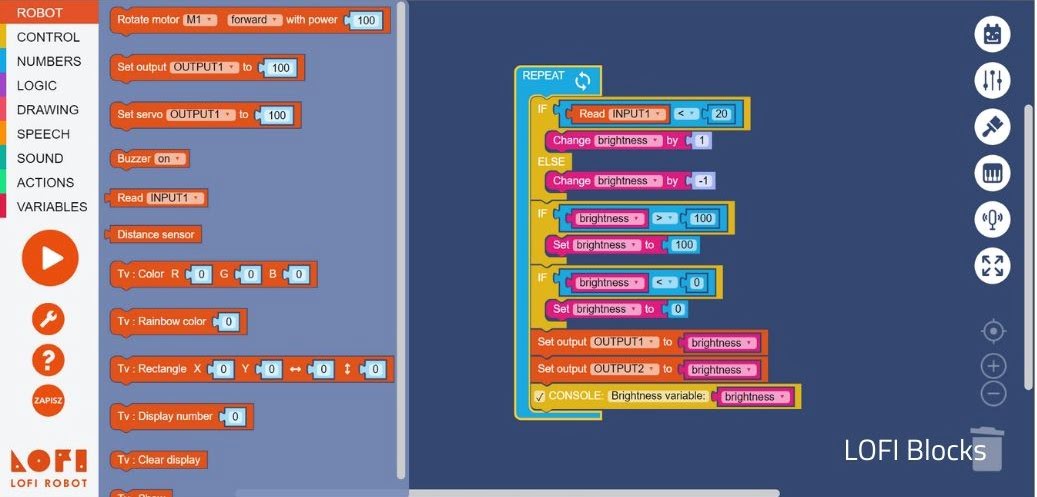
Blocks responsible for electronics are available in the Robot category. They allow you to control DC and servo motors, as well as any other input/output device: distance sensor, buzzer, or the Codebox TV LED display. Other categories include flow, math and logic blocks, variables, as well as instructions for drawing, emitting sounds and detecting events. Generally speaking, coding possibilities are considerable.
Within the app hides an interesting functionality - a speech synthesizer. With its help, you can play programmed messages in several languages.
Another asset of LOFI Blocks is that it can be used in several national languages. Considering that Codebox is a product for kids, it’s great to have the possibility of using coding commands in a language one actually understands. English may be the most commonly used language in programming, but it doesn’t mean everyone knows it from the cradle.
Unfortunately, some aspects of the app are odd. Instead of a start block, you get an infinite loop and place all programming instructions within. It is a surprising choice for an app that is supposed to be used in education. In a newly created program, a didactical approach suggests to add infinite loops only at the very end to easily spot errors in the code.
Another problem lies in sensor value presented in the form of a slider. Changes are often so small that the slider barely reflects them at all. A simple window with numbers would probably be more useful.
LOFI Robot ScratchX¶
Do you like Scratch? You can use it to program LOFI robots thanks to the unofficial expansion LOFI Robot Chrome v4. The expansion includes the same blocks as the Robot category of LOFI Blocks and a full palette of Scratch programming blocks.
Unlike the original Scratch, this expansion is recommended for slightly older kids. LOFI instructions are more complex than Scratch blocks. What’s more, they have rather abstract names and a lot of parameters.
Since it was based on Scratch 2.0, the interface differs somewhat from the Scratch version available online now. But don’t let appearances fool you - the core commands and the layout remain exactly the same.
Unfortunately, we couldn't find any user help in English on how to use ScratchX with Codebox. Custom blocks added with the Chrome extension are available only in Polish.
Nonetheless, the core of this app does not disappoint. It is user-friendly and promotes learning how to code, partly because it is based on a well-known and proven solution.
Note:
This software relies on Flash, so it’s accessibility may soon be limited.
Educational Resources¶
Codebox Starter: 5 Robots to Make¶
With one Codebox Starter set, you can build 5 different robot models: Interactive lamp, Automatic gate, Shooting range, Shuffle robot and Robot head. Building one robot takes from 20 to 40 minutes. The building system is quite challenging, but on the bright side, all instructions are easy to follow.
For school use, opt for the least complex models. Although they may not be as good-looking, you will be able to complete them with your students in time.
Materials for teachers include robot building instructions and program descriptions included in the Robot learning center (7 lessons for Codebox Starter). In addition to lesson plans designed to match particular robot models, the producer has also prepared an introductory lesson focused on sensors included in the set.
All educational content presents good quality. We’ve noticed a significant step forward since the previous generation (Edubox), but there’s still some inaccuracies and shortcomings. Step-by-step building and programming instructions are clear, but divided in an unexpected way. Building instructions are separated from the lesson materials and the lessons themselves are not clearly assigned to particular models. Some even suggest that the building instructions aren’t necessary!
So if you want to find out how the producer recommends to pair models with lessons, watch the video next to the lesson plan. Although the robots used for filming are sometimes modified in comparison to the original models, videos with programming instructions are the only place where you can learn which lesson to conduct with which robot.
These videos may be helpful for some, but are not necessary. Materials for every lesson already include a picture of the program with legible description that is much easier to use.
One way or another, save some time to get acquainted with teaching materials before you actually introduce them into your classroom.
Now, let’s take a closer look at the robot models you can build with Codebox Starter.
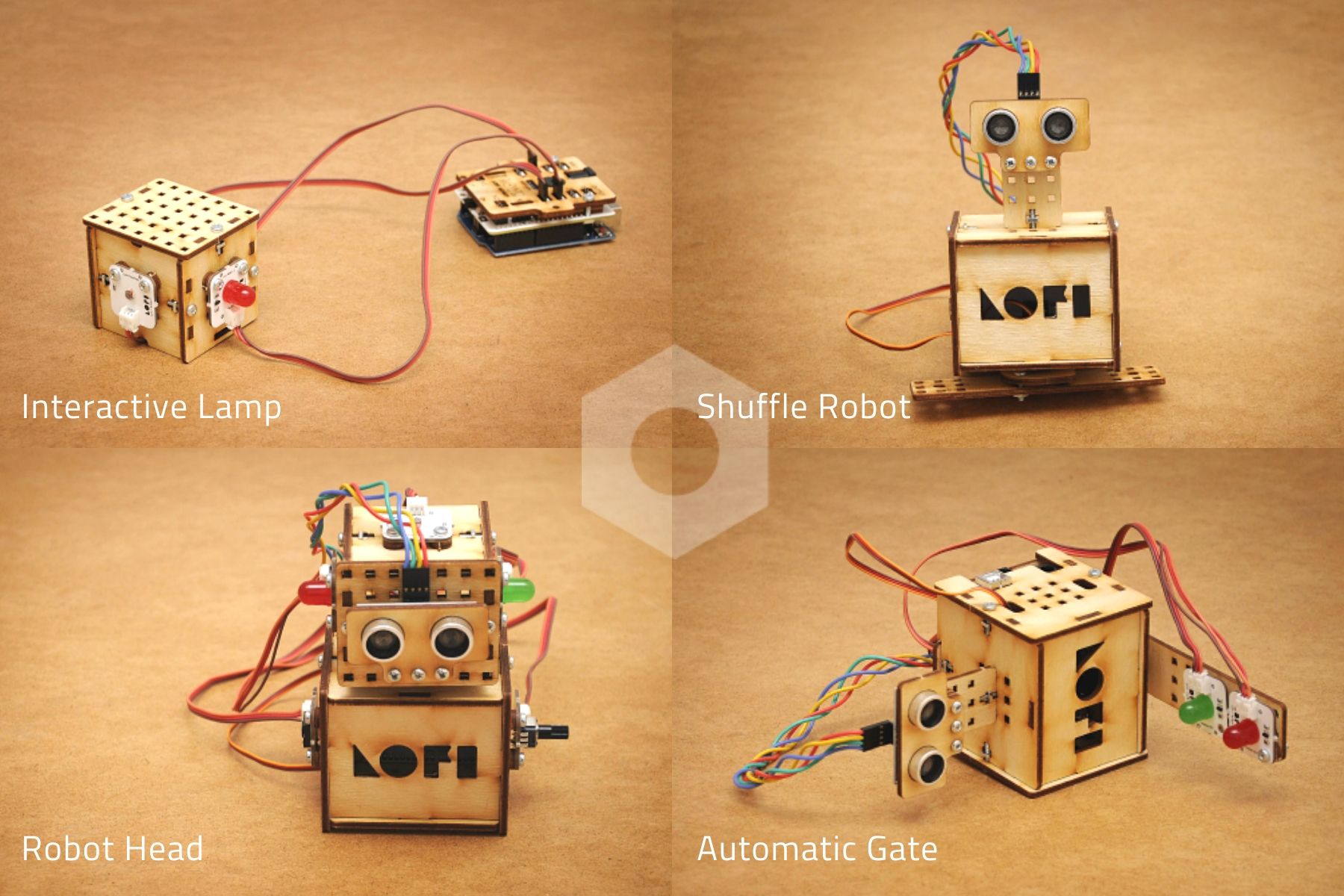
You can build 5 robots with different qualities. Interactive lamp reacts to lightning in a room; Automatic gate makes use of the distance sensor; the Shuffle robot is certainly creative - it moves forward with no wheels or legs! Creating a Shooting range from wood and sensors is also interesting, but you will need a laser pointer to use it.
Out of all robots you can build from Codebox Starter, Robot Head is the most gripping one. You can create several programs for it, all with a different objective. Some of them, especially Sonar, are quite complex and could use an explanation. Unfortunately, not all programs are. And if you are interested, you must actually head to lesson plans for teachers.
Codebox Drive: What makes them move?¶
The expansion comes with building instructions for 7 models. Robots made with Codebox Drive are definitely more interesting (they can move!), but they also require more time to build.
It’s worth noting that improvements are clearly visible in this aspect. Constructions are simplified and connections are fewer, which translates into time efficiency. Assembling these models takes around 60 minutes, so in comparison to the previous generation (Edubox),the building time was cut in two.
Building instructions for the expansion consist of technical drawings, not photos, which makes every element more visible. Yet the instructions themselves are not as refined. They sometimes lack screws put in place in previous steps, which can be misleading.
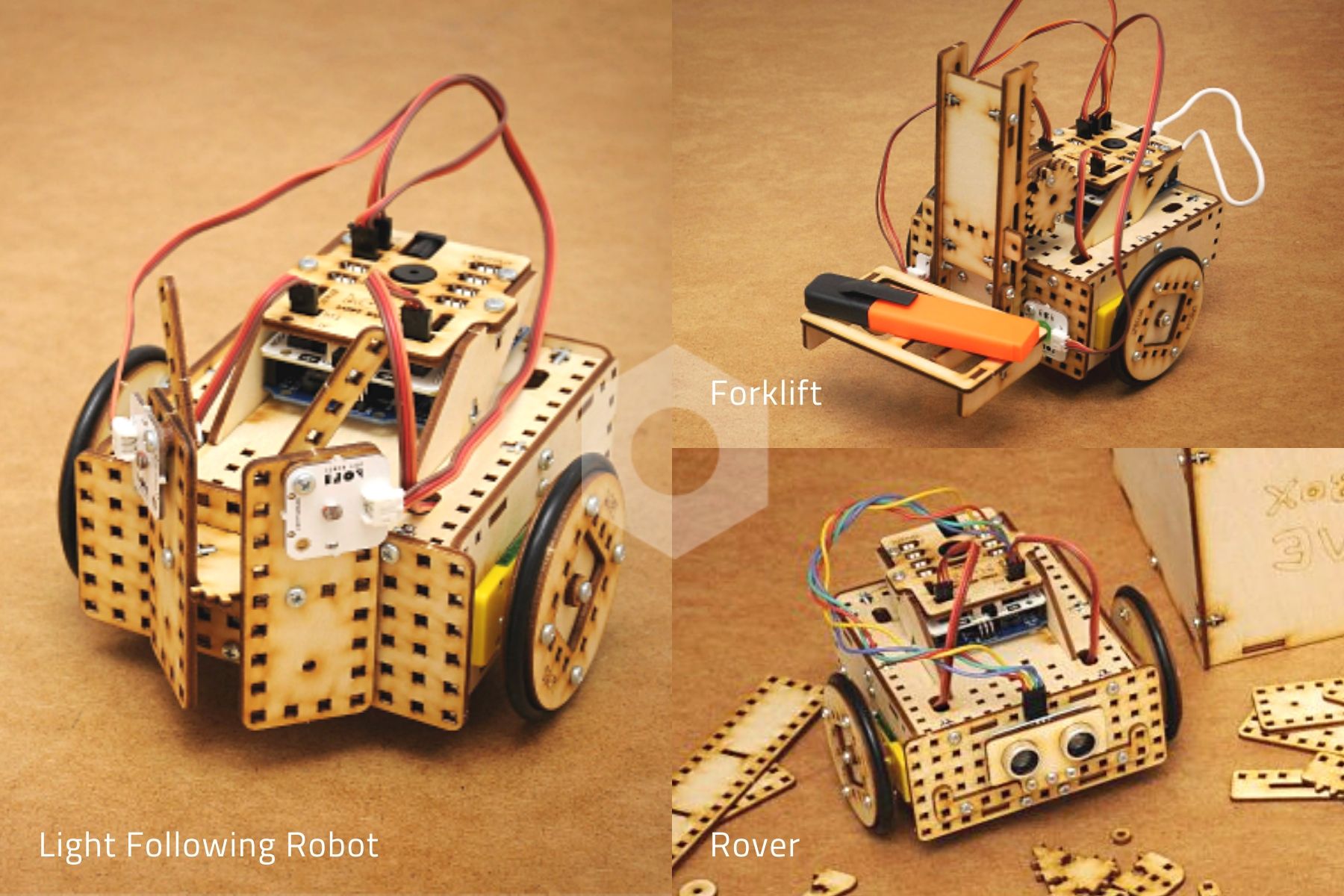
And although you can create 7 different robots, the programming is explained step by step (in Lessons) only for 3 models: Light following robot, Forklift and Rover.
Of course, you can still program Painting robot, Headmobile, Robocat and Football playing robot by using the complete script available in LOFI Robot learning center, but there are no additional instructions to support you. You must figure it out yourself.
But if you are somewhat advanced in robotics and have prior experience with other kits, they are worth trying out.
Wooden robotic kit for school?¶
If you are an attentive reader, you already know that Codebox Drive can be used in school. That’s great news!
We recommend learning with Codebox to students 12 years old (or older) and teachers, who already have some prior experience with robotic kits. Individual construction parts, nuts, bolts and bare electronics can be enticing, on the condition that they don’t overwhelm you.
When planning your curriculum, spare 90 minutes for one lesson with Codebox robots. Although 45 minutes will suffice for completing simpler projects with Codebox Starter, your students will appreciate more time for no-stress building and playing with robots. Plus, in 90 minutes they will be able to complete more complex projects as well.
Two students can simultaneously use one Codebox kit. When building some robots by LOFI, it pays to have an additional pair of hands!
Before you start building your robot, you must separate wooden parts from the laser-cut wooden sheets. Instead of forcing them out, we recommend using a box cutter – it’s easier and minimizes any damage done in the process.
Getting these sets ready for classroom use requires quite a bit of time, precision and caution (watch out for splinters!). That is why it’s best to either prepare LOFI kits before the class yourself, or dedicate one entire lesson to separating elements, assembling boxes and discussing its contents. It takes around 45 minutes.
Cost¶
- Codebox Starter – 99.99 €
- Codebox Drive – 74.99 €
- Codebox TV – 49.99 €
- Bluetooth 4.0 for LOFI Brain – 13.00 €
- Codebox Full Kit – 219.00 €
Conclusions¶
Codebox by LOFI is certainly an interesting robotic kit. Thanks to combining high-tech sensors with the wooden elements, these robots have a unique “charm” that will appeal to many.
The creators of the Codebox have made noticeable improvements from the times of their previous set. They managed to adapt the product to school requirements, mainly by simplifying construction and shortening the time needed for building every model.
All robots from the new series can be built and coded in 90 minutes. Programming with Codebox Drive robots, however, may have to be hasty. Producers achieved this record time by redesigning construction parts and decreasing the number of connections between them. Simplifying the models was instrumental.
The simplest projects from Codebox Starter look so modest that they make you wonder whether they can be classified as “robots”. Projects from Codebox Drive expansion are surely more interesting, but the difficult building system, as well as the selection of available construction parts, discourage from experiments.
The consequences of these changes are significant. The new LOFI Robot series isn’t purely a robotics kit. Instead of focusing equally on creating mechanisms and programming, lessons with Codebox will include limited building, basic programming and introduction to electronics.
Teachers working with Codebox must put aside topics related to construction and mechanics and focus on electronics and programming instead. It’s not a wrong decision, as long as it’s informed.
These changes are of importance not only for teachers and their students, but also for the producer. As a result LOFI shifts from a difficult to use, but inexpensive robotics kit to a completely different product and lands in a highly competitive market segment. Codebox should not be compared to LEGO Mindstorms or VEX IQ, since it’s actually closer to micro:bit by BBC.
Widely known micro:bit encourages kids to connect simple electronic elements controlled by a small microcontroller with any construction parts at hand, preferably recycled. Such relatively cheap modules allow not only to teach electronics and programming, but also to develop students’ creativity. With little work and imagination, a similar effect could be achieved with Codebox.
How will LOFI cope with the newfound competitors? Only time can tell.


